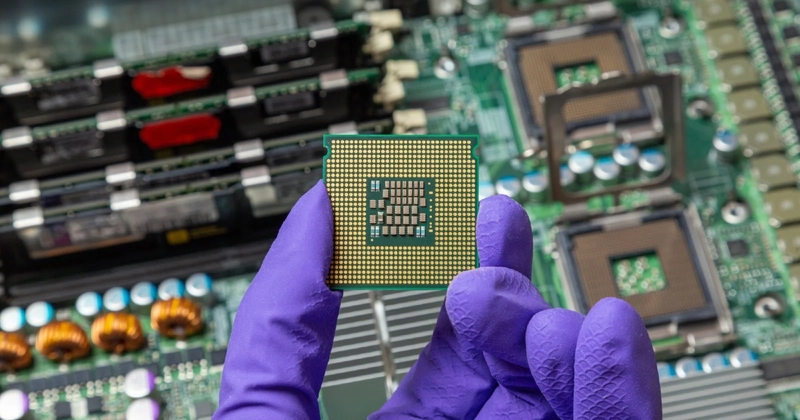Why this Book Changed How I See Chips.
I picked up this book Chip War way back in 2023 when I accidentally saw one video where Chris Miller—the author—was discussing the chips industry on Nikkei Asia (you can watch it here: link). Semiconductors have been one of the topics I always follow closely, so this isn’t simply one of those I read just to “stay informed”. Technology fascinates me. I work in factory automation—building the machines that build other machines—so chips are everywhere in what I do.
And a few chapters in, it was confirmed: I was hooked.
This book isn’t really just about chips. It’s about how the world works. How nations rise and fall. How one breakthrough in lithography, a leap in packaging design, or even a single missed investment can shift the global balance of power.
I remember I was in Tokyo, Japan at the end of 2023 for the iREX robot exhibition—one of the biggest events in the world for our robotics industry. Walking through halls filled with cutting-edge robots and automation systems, you have but to give it to these Japanese, how miraculous they have been able to rebuild their entire economy after WWII in such a short period of time, by betting on semiconductors. It’s so surreal, how the book was explaining the history behind everything I was looking at.
What impress me.
Chris Miller doesn’t try to sound impressive. He just explains things clearly. And his main point is unsettling, to say the least, when you think about it: chips aren’t just in everything anymore. They are everything.
Military capability? Economic growth? Clean energy transition? Chips. Chips. More chips. Geopolitical power in this modern age? You better control the chip supply chain.
It’s like oil, but worse. At least, oil comes from lots of different places.
The book bounces from Cold War paranoia to Japan’s rise to Taiwan’s big bet to China quietly building up their capabilities. But it doesn’t feel like lecture. It’s more like watching a thrilling - documentary about the modern world through the lens of silicon and circuits.
And here’s what really got me—this isn’t just business. This is a game of chess with billions of dollars at stake, where the players are countries’ governments. They are pouring money into building fabs even when it feels like there’s almost no clear path to profit. This is not about ROI. It’s about survival.
And here’s where it hits home.
There’s this detail right in the opening chapter of the book that blew my mind. Miller traces America’s chip obsession back to the Vietnam War—my country, where I’m living now and have been my whole life.
It was this war that forced the U.S. military to realize their technology is terrible. Their radios, navigation, weapons systems—too slow, too unreliable, too outdated.
If the U.S. wanted to stay on top, it needed to out-tech its rival, Russia and the rest of the world. And the answer to their questions? Semiconductors.
Fast forward forty years, and here we are: Vietnam—where America’s tech failed—now one of the biggest winners in the global chip economy. Companies are shifting production out of China because of the trade war, with Vietnam one of the top choice.
There’s something almost poetic, and ironic, about that. A military failure creates an entire industry, and that industry ends up lifting the very country where it all started.
But U.S. is not just sitting idly. Trump’s trade war, Biden’s CHIPS Act, further tariffs on foreign semiconductors—America wants chips production back. Problem is, you can’t just magically call forth a fab out of thin air. It takes years, costs billions, and demands expertises that’s rarer than most realize.
And while politicians argue about re-shoring on TV, those of us actually working in manufacturing have been dealing with this fragility all along. It’s ever-present.
I still remember the COVID days. Our biggest group of customers—automotive manufacturers—were completely halted. Not because they couldn’t get steel or couldn’t find workers. Because they couldn’t get chips.
A modern car might contain over 1,000 chips, and when just one of them—sometimes costing only a dollar or two—was missing, the whole production line shutdowns. I saw entire factories go dark overnight.
That wasn’t a one-time thing either. It’s gotten worse. The world’s more polarized than ever, and supply chains could break with the slightest geopolitical shock.
Here’s the scary part Miller lays out: about 90% of the world’s most advanced chips come from Taiwan. One place. If anything happens there—earthquake, political crisis, whatever—everything stops. Cars, phones, robots, your fridge. Everything.
What stayed with me?
After reading this book, you could start seeing the invisible war happening behind every device you touch. Power in the 21st century isn’t about who has the biggest army anymore. It’s about who can make the smallest, most advanced chips.
If you work in tech or manufacturing, or honestly if you just want to understand how the world actually go around now, read this book. You’ll never look at your phone the same way.
I know I don’t. Every robot, every system that we build, I think about the supply chains stretching across oceans, through countries that might not be friends tomorrow, all so we can get the chips that make everything work.
It’s a wild wild west we’re living in. And most people have no idea.
